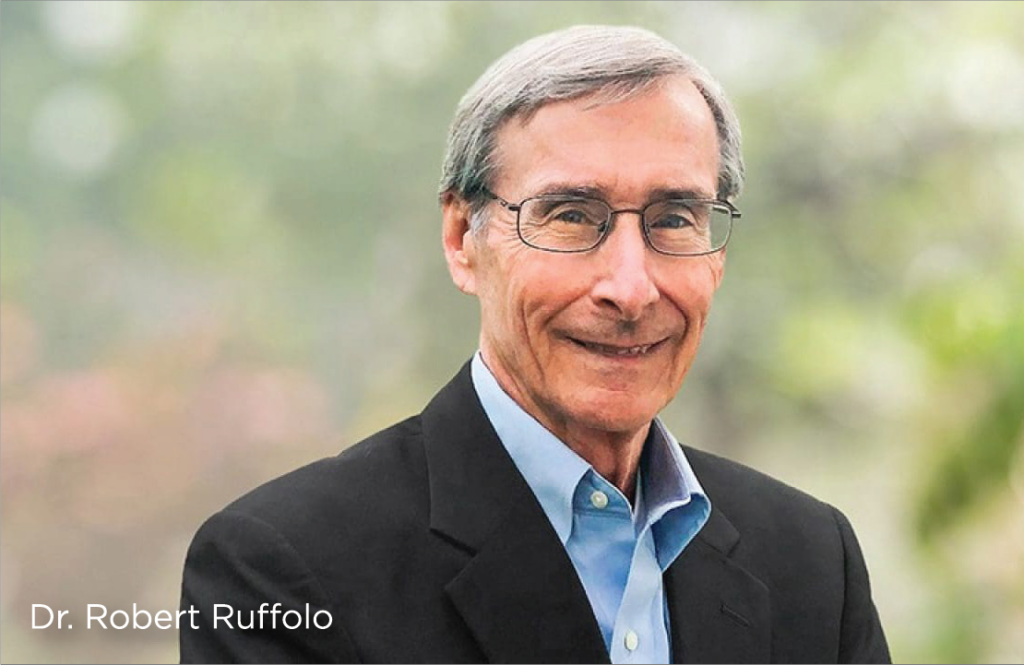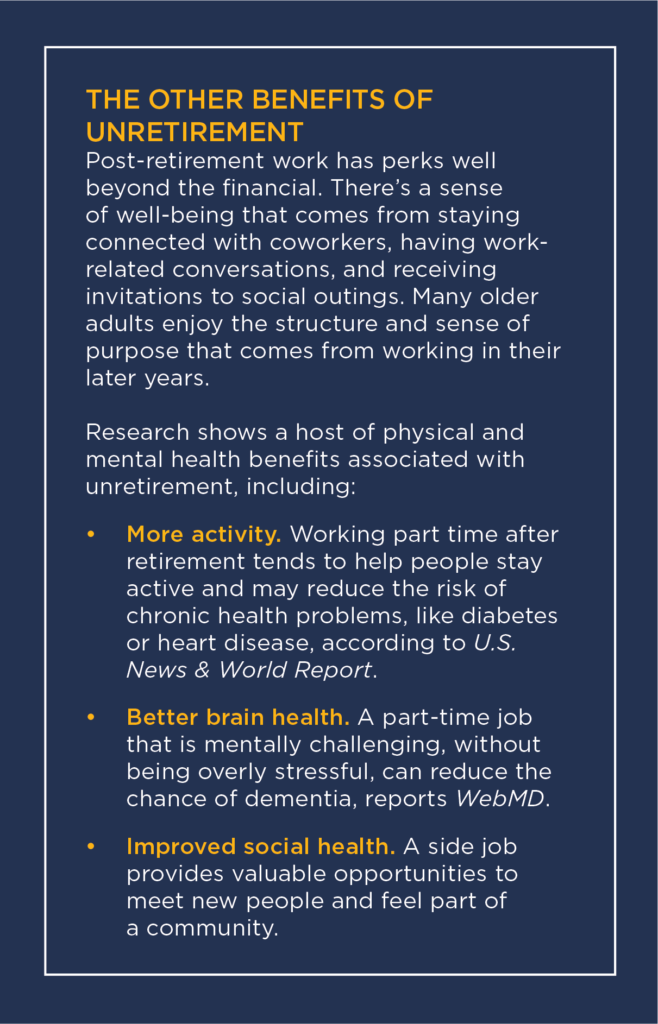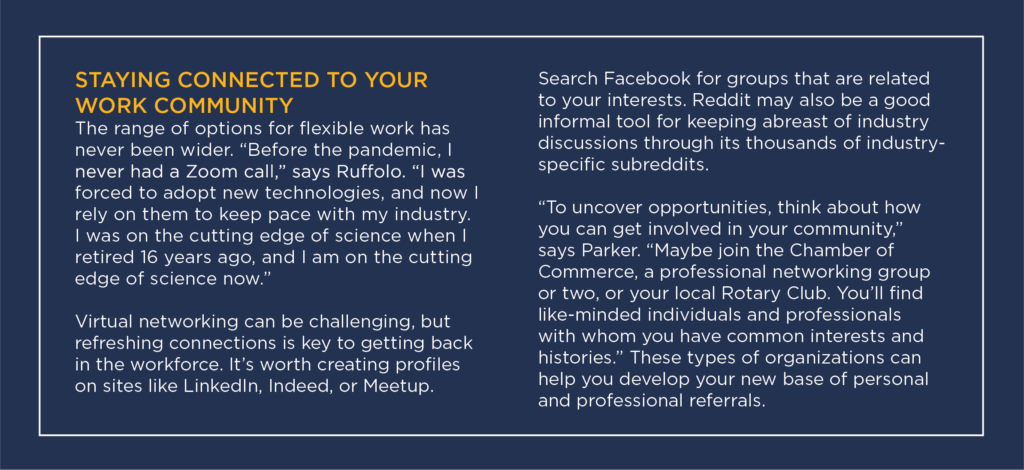Unretirement Benefits: How Today’s Retirees Are Redefining Their Roles
Ruffolo was so passionate about his work that the last thing he wanted for his later years was to spend a lot of free time relaxing. “I don’t really have hobbies,” he says. “I get so much pleasure from work [that] I don’t play golf or tennis. I don’t go out at night or drink and carouse.”
When Ruffolo first started talking about retirement, his wife, Stephany, wondered where he would direct his abundant energy. She needn’t have worried; his retirement lasted only one month. “One, I wasn’t going to sit around and watch television,” he says. “Two, I wanted to have fun.”
Fun, for him, meant advancing the science he loved, so Ruffolo designed his own version of retirement. Let’s call it unretirement.

“I have a lifetime of knowledge about how drugs are discovered and developed,” says Ruffolo. “Companies want me to help them develop these drugs, and I’ll do it as long as my health holds out. It keeps me busy, and I’m having fun, yet without the crushing burden of responsibility that I had when I was working.”
Before retiring, Ruffolo led a 9,000-person team and often worked 12 to 16 hours a day, seven days a week. He rarely slept more than four hours a night, rising at 4:00 a.m. to clear his email inbox before arriving at the office by 5:00 a.m. Now, at 74 years old, Ruffolo sets his own schedule.
“I get up at 1:30 or 2:00 a.m., never later,” he says. “I do an hour on the treadmill, 30 minutes of weights, then start work. People think I’m crazy, but it makes me happy. There’s a good feeling I get when I’m awake before other people.”
These days, Ruffolo is a consultant for several pharmaceutical companies, a board member for multiple biotech startups, and an expert witness on patent infringement lawsuits. He travels frequently to Asia, the Middle East, and Europe.
He teaches, lectures, and—with Stephany—engages in philanthropic endeavors, including renovating a lecture hall at The Ohio State University, his alma mater. It’s a packed and fulfilling life, designed very much to his own specifications.
Unretiring in Retirement
While Ruffolo’s version of work during retirement may seem extreme, the trend of unretirement has gained attention in recent years as a larger share of baby boomers approach this stage of life in innovative ways. These go-getters are creating paths that include some form of intermittent, remote, or scaled-back work. Some are trying a different field altogether.
Nearly one in five adults age 65 or older is employed today—an increase from only 11 percent in 1987, according to the Pew Research Center. Even among those 75 and older, about 9 percent are employed, more than double the share in 1987. College-educated workers are more likely to continue working than those without a college degree.
“There’s a shift in people’s idea of retiring because of how the workforce has changed, especially in the past few years,” says Evan Cumalander, a CAPTRUST financial advisor in Wenatchee, Washington. “As much of the workforce has gone virtual, some individuals who already retired have now been hired back to work remotely or have stayed on in consulting roles.”
On Your Own Terms
One factor contributing to the unretirement trend is that work has become more age-friendly and flexible due to technology tools and new social norms—like flexible hours and virtual meetings—that became more common during the pandemic.
“Before, people were waking up at 7:00 a.m., making coffee, driving to an office, and spending a lot of time away from their families,” says Cumalander. “Now, those who have perfected their craft throughout their careers can be just as effective working reduced hours virtually.”
One of Cumalander’s clients, who worked at a food distribution company, changed her whole approach to retirement when it became possible to do her job remotely. As the main contact for some strategic customer relationships, she negotiated with her employer to continue working after age 65 as a 1099 consultant.
1099 consultants are considered independent contractors, not employees. (The number 1099 refers to the tax form employers must file for each independent contractor.) As such, Cumalander’s client was ineligible for employer-sponsored health insurance, but she was able to get on Medicare.
“She lives an almost-retired lifestyle, with very flexible hours,” Cumalander says. “She’s able to keep one toe in the water, working with people she likes and having something to do, while getting supplemental income so she doesn’t have to withdraw as much from her retirement accounts.”
Cumalander sees a trend of similar trajectories. “With remote work now a common option, people can extend the length of time they work,” he says. “Instead of stopping work completely at age 65, they might start paring back at age 60 and continue working until age 70 or later.”

Connecting and Contributing
Work is often a core part of a person’s identity. And research shows that continuing to work can help people stay sharp, maintain skills, and feel they’re a part of something.
“For someone who has worked 40 to 50 hours a week for their entire life, many of their social and emotional connections may come through their workplace,” says Teri Parker, a CAPTRUST financial advisor in Riverside, California.
Leaving that world behind entirely can create a void, she says. “Suddenly, no one is calling to ask your opinion, or you’re no longer writing a paper on a new approach,” says Parker. “It can be disorienting.”
A renegotiated work-life balance can make all the difference in an enjoyable unretired lifestyle.
For instance, Cumalander points to another client: a veterinarian who sold his practice at age 59 and moved to the coast, a few hours from his former home. The new owner asked if he would support the continuity of the business by phasing out gradually instead of leaving altogether. He happily agreed.
“This client loved his work so much that he would drive for two hours and stay in an apartment at his best friend’s house on Tuesdays, Wednesdays, and Thursdays every week,” says Cumalander. “Then, he would be so excited to drive back to the beach, where every weekend was a long weekend and felt like a vacation.”
Financial Planning Implications
Working after retirement can help defer dipping into your nest egg and add structure to your days, but a paycheck can also cause unexpected repercussions for retirement income and taxes. Your age, the amount you’re earning, and the type of employment you’re engaged in are just a few of the factors to be mindful of.
Before returning to work or negotiating consulting terms, it’s good to check with a financial advisor about potential implications for your Social Security benefits and retirement withdrawal strategies.
If you aren’t yet receiving Social Security benefits, post-retirement work may allow you to delay starting, which will likely mean a higher benefit down the road. For people who are already drawing Social Security and are full retirement age or older, earned income has no impact on benefits.
However, for those younger than full retirement age, complex rules apply. For one thing, when earnings exceed $22,320, the Social Security Administration will withhold $1 from benefits for every $2 earned above that threshold. This money is credited back after full retirement age. A different rule applies the year someone reaches full retirement age.
“There are so many rules for different scenarios,” says Parker. “I would suggest people make an appointment with the Social Security Administration or with their financial advisor to clearly understand the full picture before making the decision to go back to work.”
Unretiring could also change your strategy for taking retirement distributions. “If you have income, maybe you’ll need to withhold more, or maybe you’ll want to reduce or stop taking an IRA distribution,” says Parker. “If the wages are significant, it’s a good idea to meet with a tax professional.”
When someone is drawing a pension and then returns to work at the same company, there’s a big difference between going back as a 1099 contractor and going back as a regular employee. “If you’re a consultant, you might not qualify as an employee, so you might be able to keep drawing on the pension,” says Parker. “However, returning to the company as a regular employee could create a problem. Before making any decision, talk to a pension expert in human resources to ask about constraints.”
Life expectancies today extend long past traditional retirement age, so it’s likely the unretirement lifestyle will continue to evolve. “That’s a long time to have nothing to do,” says Ruffolo. “For retirement, you should do what makes you happy. For me, it’s about staying active and giving what I have to offer.”

Article by Jeanne Lee